

Automotive News and Reviews for the Petrolhead
Reuters Motoring Commentator
In this week's issue:
- Groovy Baby!
- Saab Lifts the Lid on New Convertible
It's amazing how care-free you can feel just by rolling that roof back. The sunflower in the vase on the dashboard is smiling at you. You even start to believe you are a little bit cooler than before. I picked up my daughter from school in it and a throng of kids hailed me with phrases like "respect" and "jammin". Trust me, this does not usually happen when I do the school run.
Half Cool, Half Silly
We all know what a Beetle is. So let's get stuck into what makes this a Beetle Cabriolet: a roof that disappears. Well, almost. I have to concede that this is one of the great soft-tops of our time. At the flick of a button it whirrs back electronically in just 13 seconds. The electric windows dip down, little 'ears' at the back flip up and the Z-roof scissors back.
Not for VW the current fad of complex panels to hide the hood. It has followed the classic Beetle shape by stacking the roof up behind the rear seats. It looks half cool, half silly. If nothing else, you do have to cover it up with a giant plastic duvet.
It also means that it's a bit of a squeeze in the back. You can just about get four adults in the Cabriolet but the ones on the back wouldn't want to be there long.
You can fold all four windows down and have unbroken access to the skies and countryside all around. Or raise the windows, stick up the optional windbreak over the rear seats and you're cosseted pretty well from prevailing winds. Put the roof up and you're virtually in a coupe - the roof is that good. Unlike some old-fashioned Beetles you may have seen scuttling along the motorway looking like they're about to balloon into the heavens, the new Beetle's roof doesn't arch up at speed.
You will also be encouraged to hear that, in the event of an accident, it doesn't matter that you have no B-pillars. Two supports shoot up from behind the rear seat backrests to protect your sunburnt bonce if the car detects a roll-over. You also get dual front airbags, front seat airbags, standard ESP and seatbelt pretensioners. Equipment levels are good but the options list includes alloy wheels, CD autochanger, cruise control, leather upholstery, parking sensors and winter pack.
That's Heavy, Man
VW has welded in some industrial strength girders into the floorpan. On balance, this was a good idea because the Beetle is the most rigid open-topper I've ever driven. No scuttle shake, no rattle, just a solid steel feel. If you must quantify it, Volkswagen helpfully states that it has "transverse vibration up to 68 per cent lower than that experienced in significantly more expensive competitors". Now you know.
The extra stiffening does unfortunately mean this is one hell of a heavy car at around 1350kg. Our test car had the 1.6-litre engine with a meagre 100bhp. In this form it's best not to be in a hurry.
You can buy one with a 2.0 engine, which is a bit fruitier. There will also be a 1.4-litre version from autumn 2003 but that will probably never get off the line. A sunflower will grow faster than you can get to 60mph.
Flower Power
Speaking of which, yes, you still get a flower vase. Put a bit of mulch in the bottom of it and perhaps in time the direct sunlight through the open roof may provide you with a miniature ecosystem in your dashboard.
As I mentioned, just two models are available from launch: the 1.6 (£15,395) and the 2.0 (£17,515 - I must say that two grand for an extra 13bhp and alloy wheels sounds a bit steep). A bargain-priced £14,000 1.4 75bhp arrives in the autumn but that doesn't have an electric roof. At the same time you'll be able to buy a 1.9TDi 100bhp diesel - the only sub-£20,000 diesel convertible on sale. Now there's a claim to fame.
If you prefer automatic transmission, you'll have to opt for the 2.0 version, which can be ordered with a six-speed Tiptronic gearbox - but that works out at a very steep £18,945.
I left the Beetle Cabriolet feeling somehow groovier. No, I may not be Austin Powers but I do feel like I have sampled a bit of what it was like to live in an age of flower power and Barbarella - if not Barbie.
Using the infra-red remote control to retract the roof from seven metres away is a fun party trick for the new Saab 9-3 Aero convertible. But the success of the newcomer is a deadly serious mission for the Swedish carmaker.
In its peak year of 1998, half of all premium sector four-seater convertible sales in the UK were taken by the 9-3. Now, having seen demand for its convertible outstripped by the 3-series BMW over the past two years, Saab is back on the attack. The new generation 9-3 convertible is expected to break its previous sales record in its first full year, and rise by another 35% by 2006, when it will account for one third of all 9-3 sales.
Such ambitions are not as grand as they might first seem. The sector is booming. While premium saloon sales have grown by 12% over the past five years, demand for premium four-seat convertibles has increased by 115%. No wonder Saab has invested so much in developing the new, third-generation convertible.
Time for a Change
Chief executive Peter Augustsson is refreshingly candid in discussing the "tired" old model. "It was too narrow and not stiff enough," he says. "You sat too low, the rear window was small and it suffered from torque-steer."
The new 9-3 convertible addresses all these weaknesses. While it is marginally shorter than its forebear, a 51mm increase in width and a 70mm stretch in its wheelbase makes it much more spacious. It also feels considerably more solid, with a three-fold improvement in body stiffness and a 35% increase in rear window size.
Equally important are the active safety features. With a seemingly inexhaustible appetite for TLAs (three letter acronyms), Saab serves up a menu of MBA (mechanical brake assistance), ABS (antilock braking system), TCS (traction control system), CBC (cornering brake control) and EBD (electronic brake-force distribution), together with ESP (electronic stability programme) as standard on the top-line Aero model.
The net result is to overcome the minor shortcomings of the Vauxhall Vectra floorpan and effectively disguise any weaknesses resulting from putting 210bhp through the front wheels alone. The low profile tyres on 17 inch alloy wheels are firm at lower speeds, but offer good grip as the pace increases. With weight balanced 55/45 front to rear, the car is well balanced and the steering responds quickly to input from the oversized wheel.
Power On Tap
Power delivery is equally impressive. The all-aluminium 2.0-lite turbocharged engine is 15 kilos lighter than its predecessor and uses four valves per cylinder plus counter-rotating balancer shafts. The Mitsubishi turbocharger operates at 0.85 bar to offer 210bhp at 5,300rpm plus an impressive 221lb/ft of torque at engine speeds of between 2500 and 4000rpm.
The lesser Linear and Vector models use a less powerful 0.7 bar Garrett turbocharger to produce 175bhp / 195lb/ft from the same 2.0-litre engine or 150bhp / 177lb/ft from a smaller 1.8-litre unit. Their prices start at £23,900 for the Linear and £25,900 for the more luxurious Vector.
Idiosyncratic as Always
While the comfort and driving pleasure of the 9-3 Aero matches its German rivals, it remains distinctively Saab in character. Its origins are clear not only from the positioning of the ignition switch beside the handbrake, the exceptionally comfortable seats and the cluttered array of dashboard switches. The Aero is also idiosyncratic in its styling, with clumsily styled rear lights and an unfortunate cut line in its rear wings to accommodate the unusual soft-top folding mechanism.
The most important card in the Saab's hand remains its pricing. Though the list price is similar to its direct rivals from Audi, BMW and Mercedes, its specification levels are higher and experience suggests dealer discounts and affordable insurance will be easier to come by.
The Saab also needs servicing only every two years, which means only four hours at the dealer over 60,000 miles. It might not be the most attractive or prestigious choice, but it offers the engineering integrity, driving pleasure and aggressive pricing to maintain Saab's strong position in the booming market for four-seater convertibles.
![]() Groovy Baby!
Groovy Baby!
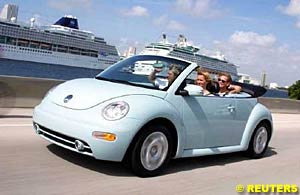 You could be forgiven for thinking that, like Austin Powers, you've been transported back to the sixties when you lift the lid of the new Beetle Cabriolet.
You could be forgiven for thinking that, like Austin Powers, you've been transported back to the sixties when you lift the lid of the new Beetle Cabriolet.
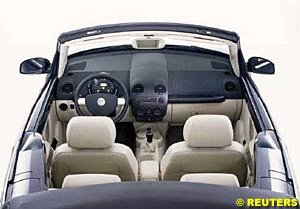 The result of this transverse vibration miracle is that handling is virtually identical to a fixed-roof Beetle. Usually with a convertible you'd expect it to wobble to and fro, rattle uncomfortably over white lines and get sent careering off-line by pine needles on the road. Far from it: the Cabriolet remains a competent handler. But in no way could you call the handling sporty. The Beetle scuttles its way round corners in unspectacular but safe fashion.
The result of this transverse vibration miracle is that handling is virtually identical to a fixed-roof Beetle. Usually with a convertible you'd expect it to wobble to and fro, rattle uncomfortably over white lines and get sent careering off-line by pine needles on the road. Far from it: the Cabriolet remains a competent handler. But in no way could you call the handling sporty. The Beetle scuttles its way round corners in unspectacular but safe fashion.
![]() Saab Lifts the Lid on New Convertible
Saab Lifts the Lid on New Convertible
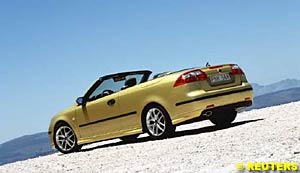 Convertibles have been an increasingly important part of the Saab model range since the original 900 soft-top debuted in autumn 1983 and took a 14% share of Saab 900 sales. The second generation 900/9-3 was even more successful, accounting for a 24% share.
Convertibles have been an increasingly important part of the Saab model range since the original 900 soft-top debuted in autumn 1983 and took a 14% share of Saab 900 sales. The second generation 900/9-3 was even more successful, accounting for a 24% share.
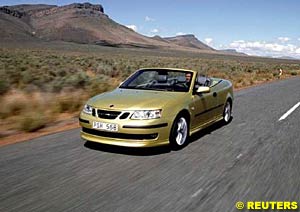 The feeling of safety this brings is reinforced by features such as pop-up roll bars, 'intelligent' airbags that modify the inflation rates according to the force of an impact and seat belts integrated into the seat frame to ensure ideal geometry irrespective of seat position. The results are impressive: The new 9-3 convertible is the first car in its sector to achieve the maximum five star rating in Euro-NCAP crash testing,
The feeling of safety this brings is reinforced by features such as pop-up roll bars, 'intelligent' airbags that modify the inflation rates according to the force of an impact and seat belts integrated into the seat frame to ensure ideal geometry irrespective of seat position. The results are impressive: The new 9-3 convertible is the first car in its sector to achieve the maximum five star rating in Euro-NCAP crash testing,
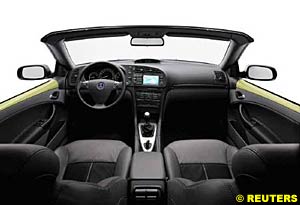 The new 6-speed manual gearbox fitted to the Aero is as smooth in use as the 5-speed automatic, allowing the range-topper to surge from rest to 60mph in 7.9 seconds and on to a top speed of 142mph. Fuel consumption remains reasonable at 31mpg but the overall impression is one of refinement. The Aero is as fast or faster than other premium sector convertibles, but feels sophisticated and comfortable - hood up or down - whatever the speed.
The new 6-speed manual gearbox fitted to the Aero is as smooth in use as the 5-speed automatic, allowing the range-topper to surge from rest to 60mph in 7.9 seconds and on to a top speed of 142mph. Fuel consumption remains reasonable at 31mpg but the overall impression is one of refinement. The Aero is as fast or faster than other premium sector convertibles, but feels sophisticated and comfortable - hood up or down - whatever the speed.
© 1995-2005 Kaizar.Com, Inc. . This service is provided under the Atlas F1 terms and conditions.
|
Volume 9, Issue 25
Atlas F1 Exclusive
Friday the 13th
Ann Bradshaw: View from the Paddock
Canadian GP Review
2003 Canadian GP Review
Finishing School
The Sweet Spot
Stats Center
Qualifying Differentials
SuperStats
Charts Center
Columns
Season Strokes
On the Road
Elsewhere in Racing
The Weekly Grapevine
> Homepage |